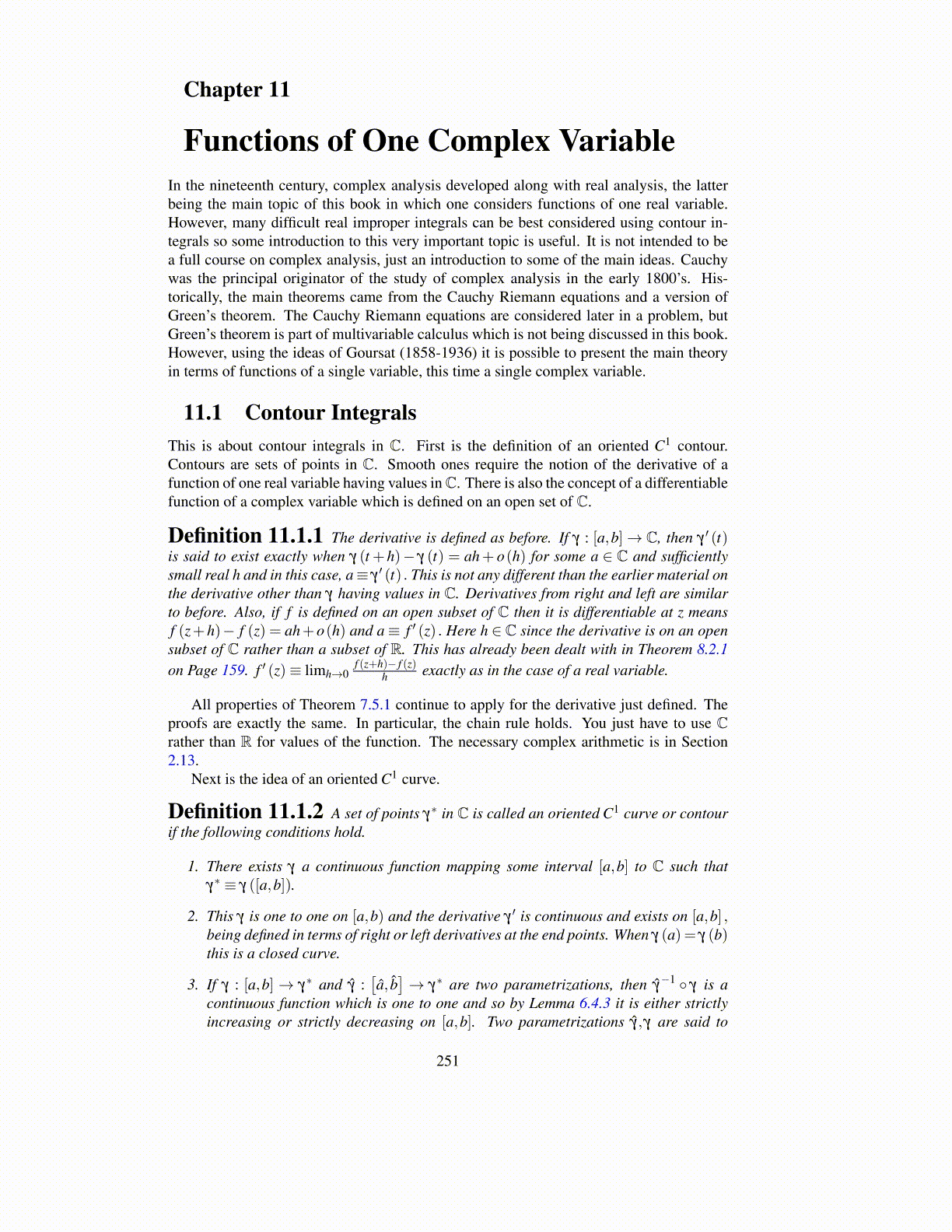
11.1. CONTOUR INTEGRALS 251
Definition 11.1.5 Let γ∗ be an oriented C1 curve having a C1 parametrization γ :[a,b]→ γ∗, then
∫γ∗
f (z)dz ≡∫ b
af (γ (t))γ
′ (t)dt ≡∫ b
aRe(
f (γ (t))γ′ (t))
dt
+i∫ b
aIm(
f (γ (t))γ′ (t))
dt
This is well defined because all the functions are continuous. Then∫
γ∗ f (z)dz is called acontour integral.
Proposition 11.1.6 The above contour integral is well defined and for γ∗ an orientedcurve, f →
∫γ∗ f (z)dz is a complex linear map meaning that for a,b ∈ C,
∫γ∗(a f (z)+bg(z))dz = a
∫γ∗
f (z)dz+b∫
γ∗g(z)dz
Also∫
γ∗ f (z)dz = −∫−γ∗ f (z)dz. In addition to this, if M ≥ max{| f (z)| : z ∈ γ∗} , one
obtains the estimate∣∣∣∫γ∗ f (z)dz
∣∣∣ ≤ML where L is the length of γ∗ defined as∫ b
a |γ ′ (t)|dtfor γ a parametrization for γ∗. This number L is well defined. If fn converges uniformly tof on γ∗, then limn→∞
∫γ
fn (z)dz =∫
γf (z)dz
Proof: The claim about the contour integral being linear is a routine computation fromdoing arithmetic for complex numbers and the above definition. This is obvious for a,breal. In case b = 0 and a = i,
i∫
γ∗f (z)dz ≡ i
(∫ b
aRe(
f (γ (t))γ′ (t))
dt + i∫ b
aIm(
f (γ (t))γ′ (t))
dt)
= i∫ b
aRe(
f (γ (t))γ′ (t))
dt−∫ b
aIm(
f (γ (t))γ′ (t))
dt∫γ∗
i f (z)dz ≡∫ b
a
(iRe
(f (γ (t))γ
′ (t))− Im
(f (γ (t))γ
′ (t)))
dt
which is the same thing because it holds for Riemann sums approximating the variousintegrals.
From consideration of real and imaginary parts, the usual change of variables for-mula holds. If γ, γ̂ are two equivalent parametrizations giving the same orientation, γ :[a,b] → γ∗ and γ̂ : [c,d] → γ∗. I need to show these give the same thing for the con-
tour integral. Let s = γ̂−1 ◦ γ (t) so ds =
(γ̂−1 ◦ γ
)′(t)dt. Also γ (t) = γ̂
(γ̂−1 ◦ γ (t)
)so γ ′ (t) = γ̂
′(
γ̂−1 ◦ γ (t)
)(γ̂−1 ◦ γ
)′(t)
∫ d
cf (γ̂ (s)) γ̂
′ (s)ds =∫ b
af(
γ̂
(γ̂−1 ◦ γ (t)
))γ̂′(
γ̂−1 ◦ γ (t)
)(γ̂−1 ◦ γ
)′(t)dt
=∫ b
af (γ (t))γ
′ (t)dt